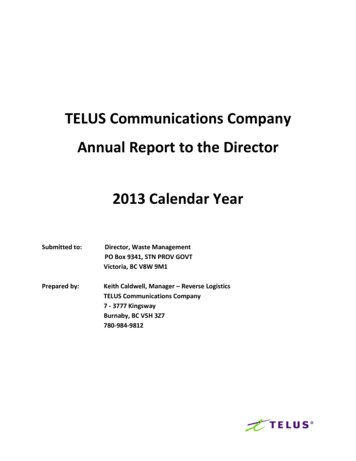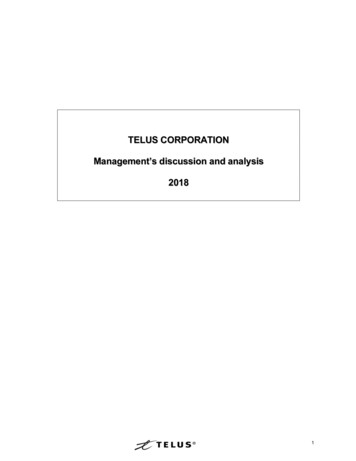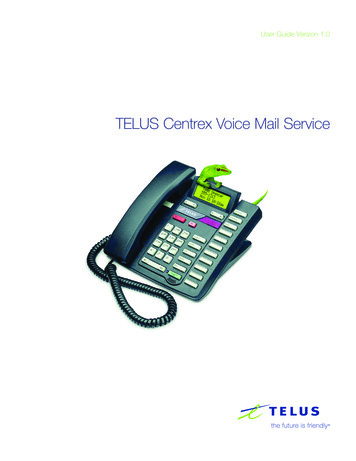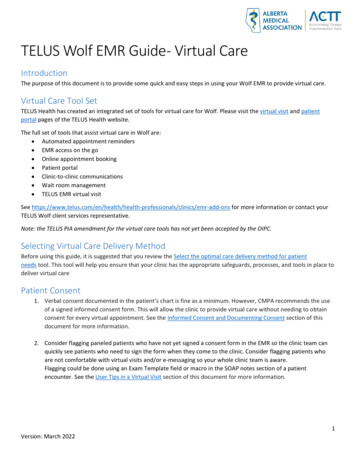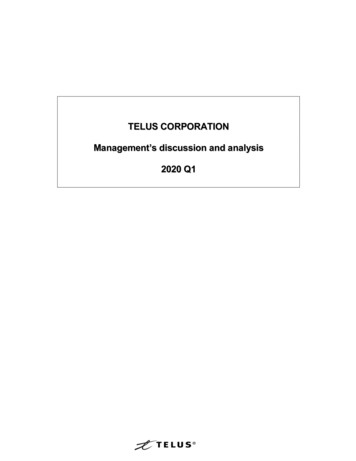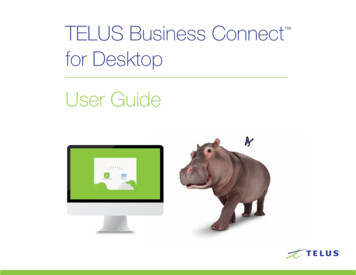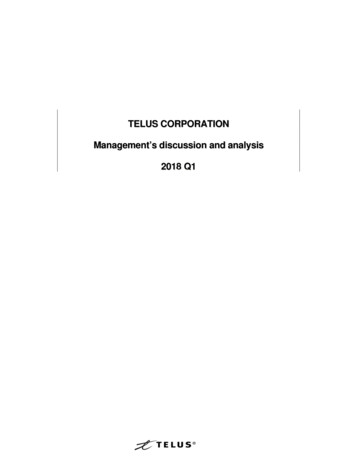
Transcription
TELUS CORPORATIONManagement’s discussion and analysis2018 Q1
TELUS Corporation – Management’s discussion and analysis – 2018 Q1Caution regarding forward-looking statementsThis document contains forward-looking statements about expected events and the financial and operating performance of TELUSCorporation. The terms TELUS, the Company, we, us and our refer to TELUS Corporation and, where the context of the narrativepermits or requires, its subsidiaries.Forward-looking statements include any statements that do not refer to historical facts. They include, but are not limited to,statements relating to our objectives and our strategies to achieve those objectives, our targets, outlook, updates, and our multi-yeardividend growth program. Forward-looking statements are typically identified by the words assumption, goal, guidance, objective,outlook, strategy, target and other similar expressions, or future or conditional verbs such as aim, anticipate, believe, could, expect,intend, may, plan, predict, seek, should, strive and will.By their nature, forward-looking statements are subject to inherent risks and uncertainties and are based on assumptions,including assumptions about future economic conditions and courses of action. These assumptions may ultimately prove to have beeninaccurate and, as a result, our actual results or events may differ materially from expectations expressed in or implied by the forwardlooking statements. An update to our assumptions for 2018 is in Section 9 Update to general trends, outlook and assumptions, andregulatory developments and proceedings in this Management’s discussion and analysis (MD&A).Risks and uncertainties that could cause actual performance or events to differ materially from the forward-looking statementsmade herein and in other TELUS filings include, but are not limited to, the following: Competition including: our ability to continue to retain customers through an enhanced customer service experience, includingthrough the deployment and operation of evolving wireless and wireline network; the ability of industry competitors to successfullylaunch their respective platforms and to combine a mix of long distance, high-speed Internet access (HSIA) and, in some cases,wireless services under one bundled and/or discounted monthly rate, along with their existing broadcast or satellite-based TVservices; the success of new products, new services and supporting systems, such as Internet of Things (IoT) services forInternet-connected devices; continued intense rivalry across all services among wireless and wireline telecommunicationscompanies, cable-TV providers, other communications companies and over-the-top (OTT) services, which, among other things,places pressures on current and future average billing per subscriber unit per month (ABPU) (as described in Section 5Discussion of operations), average revenue per subscriber unit per month (ARPU), cost of acquisition, cost of retention and churnrate for all services, as do customer usage patterns, flat-rate pricing trends for voice and data, inclusive rate plans for voice anddata and availability of Wi-Fi networks for data; mergers and acquisitions of industry competitors; pressures on high-speed Internetand TV ARPU and churn rate resulting from market conditions, government actions and customer usage patterns; residential andbusiness network access line (NAL) losses; subscriber additions and retention volumes, and associated costs for wireless, TV andhigh-speed Internet services; and our ability to obtain and offer content on a timely basis across multiple devices on wireless andTV platforms at a reasonable cost. Technological substitution including: reduced utilization and increased commoditization of traditional wireline voice local and longdistance services from impacts of OTT applications and wireless substitution, a declining overall market for paid TV services,including as a result of content piracy and signal theft and as a result of a rise in OTT direct to consumer video offerings and virtualmultichannel video programming distribution platforms; the increasing number of households that have only wireless and/orInternet-based telephone services; potential wireless ABPU and ARPU declines as a result of, among other factors, substitution tomessaging and OTT applications; substitution to increasingly available Wi-Fi services; and disruptive technologies such as OTT IPservices, including Network as a Service in the business market, that may displace or re-rate our existing data services. Technology including: subscriber demand for data that may challenge network and spectrum capacity levels in the future andmay be accompanied by increases in delivery cost; our reliance on information technology and our need to streamline our legacysystems; technology options, evolution paths and roll-out plans for video distribution platforms and telecommunications networktechnologies (including broadband initiatives, such as fibre to the premises (FTTP), wireless small-cell deployment, 5G wirelessand availability of resources and ability to build out adequate broadband capacity); our reliance on wireless network accessagreements, which have facilitated our deployment of wireless technologies; choice of suppliers and those suppliers’ ability tomaintain and service their product lines, which could affect the success of upgrades to, and evolution of, technology that we offer;supplier concentration and market power for network equipment, TELUS TV and wireless handsets; the performance of wirelesstechnology; our expected long-term need to acquire additional spectrum capacity through future spectrum auctions and from thirdparties to address increasing demand for data; deployment and operation of new wireline broadband network technologies at areasonable cost and availability and success of new products and services to be rolled out using such network technologies;network reliability and change management; self-learning tools and automation that may change the way we interact withcustomers; and uncertainties around our strategy to replace certain legacy wireline network technologies, systems and services toreduce operating costs.2 of 90
TELUS Corporation – Management’s discussion and analysis – 2018 Q1 Regulatory decisions and developments including: the potential of government intervention to further increase wirelesscompetition; the potential for appeals of, or government intervention further to, the impact from the CRTC’s determinations forwholesale GSM-based domestic roaming and the setting of such rates charged to wireless service providers (WSPs) on aretroactive basis; future spectrum auctions and spectrum policy determinations, including the amount of spectrum TELUS is ableto acquire and its cost under the recently announced Technical, Policy and Licensing Framework for Spectrum in the 600 MHzBand, as well as cost and availability of spectrum in the 3500 MHz band; restrictions on the purchase, sale and transfer ofspectrum licences; the impact of the CRTC’s wireline wholesale services review, with a formal review of rates for wholesale FTTPaccess still to be commenced for TELUS; changes to the cost burden associated with CRTC-mandated network interconnections;disputes with certain municipalities regarding rights-of-way bylaws; and other potential threats to unitary federal regulatoryauthority over telecommunications, including provincial wireless and consumer protection legislation; the potential impacts of theCRTC’s decision to require pro-rated refunds when customers terminate their services; the CRTC’s proposed phase-out of thelocal service subsidy regime and corresponding establishment of a broadband funding regime to support the enhancement ofhigh-speed Internet services focusing on underserved areas in Canada; the impact of the review of the Minister of CanadianHeritage’s new Creative Canada policy framework announced on September 28, 2017; the CRTC’s consultation and report ondistribution models of the future; vertical integration in the broadcasting industry resulting in competitors owning broadcast contentservices, and timely and effective enforcement of related regulatory safeguards; the review of the Copyright Act, which began inearly 2018; the federal government’s stated intention to review the Broadcasting Act and Telecommunications Act as announcedin the March 22, 2017 federal budget; the outcome of TELUS’ applications for renewal of its broadcasting distribution licences; theNorth American Free Trade Agreement renegotiation; and restrictions on non-Canadian ownership and control of TELUSCommon Shares and the ongoing monitoring and compliance with such restrictions. Capital expenditure levels and potential outlays for spectrum licences in spectrum auctions or from third parties, due to: ourbroadband initiatives, including connecting more homes and businesses directly to fibre; our ongoing deployment of newerwireless technologies, including wireless small cells to improve coverage and capacity and prepare for a more efficient and timelyevolution to 5G wireless services; utilizing acquired spectrum; investments in network resiliency and reliability; subscriber demandfor data; evolving systems and business processes; implementing efficiency initiatives; supporting large complex deals; and futurewireless spectrum auctions held by Innovation, Science and Economic Development Canada (ISED) including the 600 MHzspectrum auction scheduled to take place in March 2019 which will result in increased expenditures. Our capital expenditure levelscould be impacted if we do not achieve our targeted operational and financial results. Human resource matters including: recruitment, retention and appropriate training in a highly competitive industry, and the level ofemployee engagement. Operational performance and business combination risks including: our reliance on legacy systems and ability to implement andsupport new products and services and business operations in a timely manner; our ability to implement effective changemanagement for system replacements and upgrades, process redesigns and business integrations (such as our ability tosuccessfully integrate acquisitions, complete divestitures or establish partnerships in a timely manner, and realize expectedstrategic benefits, including those following compliance with any regulatory orders); the implementation of complex largeenterprise deals that may be adversely impacted by available resources, system limitations and degree of co-operation from otherservice providers; our ability to successfully manage operations in foreign jurisdictions, including managing risks such as currencyfluctuations; information security and privacy breaches, including data loss or theft of data; intentional threats to our infrastructureand business operations; and real estate joint venture re-development risks. Business continuity events including: our ability to maintain customer service and operate our networks in the event of humanerror or human-caused threats, such as cyberattacks and equipment failures that could cause various degrees of networkoutages; supply chain disruptions including as a result of government restrictions or trade actions; natural disaster threats;epidemics; pandemics; political instability in certain international locations; and the completeness and effectiveness of businesscontinuity and disaster recovery plans and responses. Ability to successfully implement cost reduction initiatives and realize planned savings, net of restructuring and other costs, withoutlosing customer service focus or negatively affecting business operations. Examples of these initiatives are: our operatingefficiency and effectiveness program to drive improvements in financial results, including the future benefits of the 2016immediately vesting transformative compensation initiative; business integrations; business product simplification; businessprocess outsourcing; offshoring and reorganizations, including any full-time equivalent (FTE) employee reduction programs;procurement initiatives; and real estate rationalization. Additional revenue and cost efficiency and effectiveness initiatives willcontinue to be assessed and implemented. Financing and debt requirements including: our ability to carry out financing activities, and our ability to maintain investment gradecredit ratings in the range of BBB or the equivalent. Ability to sustain our dividend growth program through 2019. This program may be affected by factors such as the competitiveenvironment, economic performance in Canada, our earnings and free cash flow, our levels of capital expenditures and spectrumlicence purchases, acquisitions, the management of our capital structure, and regulatory decisions and developments. Quarterlydividend decisions are subject to assessment and determination by our Board of Directors (Board) based on the Company’sfinancial position and outlook. Shares may be purchased under our normal course issuer bid (NCIB) when and if we consider itopportunistic, based on the Company’s financial position and outlook, and the market price of TELUS shares. There can be noassurance that our dividend growth program or any NCIB will be maintained, not changed and/or completed through 2019.3 of 90
TELUS Corporation – Management’s discussion and analysis – 2018 Q1 Taxation matters including: interpretation of complex domestic and foreign tax laws by the tax authorities that may differ from ourinterpretations; the timing of income and deductions, such as tax depreciation and operating expenses; changes in tax laws,including tax rates; tax expenses being materially different than anticipated, including the taxability of income and deductibility oftax attributes; elimination of income tax deferrals through the use of different tax year-ends for operating partnerships andcorporate partners; and tax authorities adopting more aggressive auditing practices, for example, tax reassessments or adversecourt decisions impacting the tax payable by us. Litigation and legal matters including: our ability to successfully respond to investigations and regulatory proceedings; our ability todefend against existing and potential claims and lawsuits, including intellectual property infringement claims and class actionsbased on consumer claims, data, privacy or security breaches and secondary market liability; and the complexity of legalcompliance in domestic and foreign jurisdictions, including compliance with anti-bribery and foreign corrupt practices laws. Health, safety and the environment including: lost employee work time resulting from illness or injury, public concerns related toradio frequency emissions, environmental issues affecting our business including climate change, waste and waste recycling, risksrelating to fuel systems on our properties, and changing government and public expectations regarding environmental matters andour responses. Economic growth and fluctuations including: the state of the economy in Canada, which may be influenced by economic and otherdevelopments outside of Canada, including potential outcomes of yet unknown policies and actions of foreign governments; futureinterest rates; inflation; unemployment levels; effects of fluctuating oil prices; effects of low business spending (such as reducinginvestments and cost structure); pension investment returns, funding and discount rates; and Canadian dollar: U.S. dollarexchange rates.These risks are described in additional detail in Section 9 General trends, outlook and assumptions, and regulatory developmentsand proceedings and Section 10 Risks and risk management in our 2017 annual MD&A. Those descriptions are incorporated byreference in this cautionary statement but are not intended to be a complete list of the risks that could affect the Company.Many of these factors are beyond our control or our current expectations or knowledge. Additional risks and uncertainties notcurrently known to us or that we currently deem to be immaterial may also have a material adverse effect on our financial position,financial performance, cash flows, business or reputation. Except as otherwise indicated in this document, the forward-lookingstatements made herein do not reflect the potential impact of any non-recurring or special items or any mergers, acquisitions,dispositions or other business combinations or transactions that may be announced or that may occur after the date of this document.Readers are cautioned not to place undue reliance on forward-looking statements. Forward-looking statements in this documentdescribe our expectations and are based on our assumptions as at the date of this document and are subject to change after this date.Except as required by law, we disclaim any intention or obligation to update or revise any forward-looking statements.This cautionary statement qualifies all of the forward-looking statements in this MD&A.4 of 90
TELUS Corporation – Management’s discussion and analysis – 2018 Q1Management’s discussion and analysis (MD&A)May 10, 2018ContentsSectionDescription1.Introduction2.Core business and strategy3.Corporate priorities for 20184.Capabilities4.1 Principal markets addressed and competition4.2 Operational resources4.3 Liquidity and capital resources4.4 Changes in internal control over financial reporting5.Discussion of operations5.1 General5.2 Summary of consolidated quarterly results and trends5.3 Consolidated operations5.4 Wireless segment5.5 Wireline segment6.Changes in financial position7.Liquidity and capital resources7.1 Overview7.2 Cash provided by operating activities7.3 Cash used by investing activities7.4 Cash provided (used) by financing activities7.5 Liquidity and capital resource measures7.6 Credit facilities7.7 Sale of trade receivables7.8 Credit ratings7.9 Financial instruments, commitments and contingent liabilities7.10 Outstanding share information7.11 Transactions between related parties8.Accounting matters8.1 Critical accounting estimates8.2 Accounting policy developments9.Update to general trends,outlook and assumptions,and regulatory developmentsand proceedings9.1 Telecommunications industry regulatory developments and proceedings10.Risks and risk management11.Definitions and reconciliations1.1 Preparation of the MD&A1.2 The environment in which we operate1.3 Consolidated highlights11.1 Non-GAAP and other financial measures11.2 Operating indicators5 of 90
TELUS Corporation – Management’s discussion and analysis – 2018 Q11. IntroductionThe forward-looking statements in this section, including estimates regarding economic growth, are qualified by theCaution regarding forward-looking statements at the beginning of this Management’s discussion and analysis (MD&A).1.1 Preparation of the MD&AThe following sections present a discussion of our consolidated financial position and performance for the three-monthperiod ended March 31, 2018, and should be read together with our March 31, 2018, condensed interim consolidatedfinancial statements (interim consolidated financial statements). The generally accepted accounting principles (GAAP)we use are the International Financial Reporting Standards (IFRS) as issued by the International Accounting StandardsBoard (IASB). Our interim consolidated financial statements comply with IFRS-IASB and Canadian GAAP and havebeen prepared in accordance with International Accounting Standard 34, Interim Financial Reporting. In this MD&A, theterm IFRS is used to refer to these standards. We adopted IFRS 9, Financial Instruments and IFRS 15, Revenue fromContracts with Customers on January 1, 2018 with retrospective application. See Section 5.2 Summary of consolidatedquarterly results and trends, Section 5.4 Wireless segment, and Section 5.5 Wireline segment of the MD&A andNote 2(c) of the interim consolidated financial statements for reconciliations of results excluding IFRS 15 effects. In ourdiscussion, we also use certain non-GAAP financial measures to evaluate our performance, monitor compliance withdebt covenants and manage our capital structure. These measures are defined, qualified and reconciled with the nearestGAAP measures in Section 11.1. All currency amounts are in Canadian dollars, unless otherwise specified.Additional information relating to the Company, including our annual information form and other filings with securitiescommissions or similar regulatory authorities in Canada, is available on SEDAR (sedar.com). Our filings with theSecurities and Exchange Commission in the United States, including Form 40-F, are available on EDGAR (sec.gov).Our disclosure controls and procedures are designed to provide reasonable assurance that all relevant information isgathered and reported to senior management on a timely basis, so that informed decisions can be made regardingappropriate public disclosure. This MD&A and the interim consolidated financial statements were reviewed by our AuditCommittee and authorized by our Board of Directors (our Board) for issuance on May 10, 2018.In this MD&A, unless otherwise indicated, results for the first quarter of 2018 (three-month period endedMarch 31, 2018) are compared with results from the first quarter of 2017, adjusted for the retrospective application ofIFRS 9, Financial Instruments and IFRS 15, Revenue from Contracts with Customers (three-month period endedMarch 31, 2017).1.2 The environment in which we operateThe success of our business and the challenges we face can best be understood with reference to the environment inwhich we operate, including broader economic factors that affect our customers and us, and the competitive nature ofour industry. Our estimates regarding our environment also form an important part of the assumptions on which ourtargets are based.Economic growthWe have updated some of our assumptions since our 2017 annual MD&A. We now estimate that the rate of economicgrowth in Canada in 2018 will be 2.1% (previously 2.2%) based on a composite of estimates from Canadian banks andother sources. For our incumbent local exchange carrier (ILEC) provinces in Western Canada, we currently estimate thatannual rates of economic growth will be 2.5% in 2018 in British Columbia (B.C.) (unchanged from our 2017 annualMD&A), and 2.4% in Alberta (unchanged from our 2017 annual MD&A). The Bank of Canada’s April 2018 MonetaryPolicy Report estimated economic growth in Canada will be 2.0% in 2018. The extent to which these economic growthestimates affect us and the timing of their impact will depend upon the actual experience of specific sectors of theCanadian economy.In respect of the national unemployment rate, Statistics Canada’s Labour Force Survey reported a rate of 5.8% forMarch 2018 (5.7% for December 2017 and 6.7% for March 2017). The unemployment rate for B.C. was 4.7% forMarch 2018 (4.6% for December 2017 and 5.4% for March 2017), while the unemployment rate for Alberta was 6.3% forMarch 2018 (6.9% for December 2017 and 8.4% for March 2017).6 of 90
TELUS Corporation – Management’s discussion and analysis – 2018 Q11.3 Consolidated highlightsAlarmForce Industries Inc.On January 4, 2018, we acquired the customers, assets and operations of AlarmForce Industries Inc. (AlarmForce) inB.C., Alberta and Saskatchewan for cash consideration of approximately 68 million. This acquisition, combined with ourgrowing gigabit-capable TELUS PureFibre network, was made with a view to accelerating our position in smart homeand security services, and providing us with the ability to offer our customers additional services as part of a bundle in thefuture.Xavient Information SystemsOn February 6, 2018, through our TELUS International (Cda) Inc. subsidiary, we closed an acquisition of 65% of XavientInformation Systems (Xavient), a group of information technology consulting and software services companies withfacilities in the U.S. and India. The investment was made with a view to enhancing our ability to provide complex andhigher-value information technology services, improving our related sales and solutioning capabilities, and acquiringmulti-site redundancy in support of other facilities.Long-term debt issueOn March 1, 2018, we issued 600 million of senior unsecured notes at 3.625% due March 1, 2028 and 150 millionthrough the re-opening of Series CW notes at 4.70% due March 6, 2048. The net proceeds were used to repayapproximately 725 million of outstanding commercial paper, as well as to fund the repayment, on maturity, of aportion of the 250 million principal amount outstanding on TELUS’ Series CS Notes due March 27, 2018, and forgeneral corporate purposes.7 of 90
TELUS Corporation – Management’s discussion and analysis – 2018 Q1Consolidated highlights2018Three-month periods ended March 31 ( millions, except footnotes and unless noted otherwise)2017ChangeApplying IFRS 9 and IFRS 15(2017 adjusted),except as notedConsolidated statements of incomeOperating revenuesOperating incomeIncome before income taxesNet incomeNet income attributable to Common SharesAdjusted Net Income13,3777195634124104353,1837035654224144186.0 %2.3 %(0.4)%(2.4)%(1.0)%4.1 %Earnings per share (EPS) ( )Basic EPSAdjusted basic EPS1Diluted EPSDividends declared per Common Share ( )0.690.730.690.50500.700.710.700.48(1.4)%2.8 %(1.4)%5.2 %5955910.8 %Basic weighted-average Common Shares outstanding (millions)Consolidated statements of cash flowsCash provided by operating activitiesCash used by investing activitiesCapital expenditures283870918.2 %(932)(650)(822)(724)13.4 ,23541,23938.92172.73Cash provided (used) by financing activitiesn/mOther highlightsSubscriber connections3 (thousands)Earnings before interest, income taxes, depreciation and amortization (EBITDA)1Restructuring and other costs1Adjusted EBITDA1,4Adjusted EBITDA margin5 (%)Free cash flow1Net debt to EBITDA – excluding restructuring and other costs1,6 (times)3.0 %2.7 %n/m5.2 %(0.3) pts.104.1 %n/mNotations used in MD&A: n/m – not meaningful; pts. – percentage points.1Non-GAAP and other financial measures. See Section 11.1 Non-GAAP and other financial measures.2Capital expenditures include assets purchased, but not yet paid for, and consequently differ from Cash payments for capital assets, excludingspectrum licences, as reported on the condensed interim consolidated statements of cash flows.3The sum of active wireless subscribers, residential network access lines (NALs), high-speed Internet access subscribers and TELUS TVsubscribers, measured at the end of the respective periods based on information in billing and other systems. Effective April 1, 2017, postpaidsubscribers, total subscribers and associated operating statistics (gross additions, net additions, average billing per subscriber unit per month(ABPU), average revenue per subscriber unit per month (ARPU) and churn) were adjusted to include an estimated migration of 85,000Manitoba Telecom Services Inc. (MTS) subscribers in the opening subscriber balances. Subsequent to this, on October 1, 2017, totalsubscribers and associated operating statistics were adjusted to reduce estimated migrations of MTS subscribers by 11,000 to 74,000.Cumulative subscriber connections also include an April 1, 2017 adjustment to remove approximately 19,000 prepaid and 25,000 postpaidsubscriptions from the respective subscriber bases, primarily due to our national CDMA network shutdown.4Adjusted EBITDA for the first quarters of 2018 and 2017 excludes restructuring and other costs.5Adjusted EBITDA margin is Adjusted EBITDA divided by Operating revenues.62017 amount excludes the effects of implementing IFRS 9 and IFRS 15. Had the 2018 amount excluded the effects of implementing IFRS 9and IFRS 15, the 2018 amount would be 2.77. (See Section 7.5 Liquidity and capital resource measures.)Operating highlights Consolidated operating revenues increased by 194 million in the first quarter of 2018:Service revenues increased by 124 million in the first quarter of 2018, mainly due to growth in wireless networkrevenue and wireline data services revenue, partly offset by the ongoing decline in legacy wireline voice revenue.Equipment revenues increased by 57 million in the first quarter of 2018, largely due to higher wirelessequipment revenue resulting from increases in retention volumes and postpaid gross additions.Other operating income increased by 13 million in the first quarter of 2018, primarily due to higher gains onsales of certain assets, and property, plant and equipment.For additional details on operating revenues, see Section 5.4 Wireless segment and Section 5.5 Wirelinesegment.8 of 90
TELUS Corporation – Management’s discussion and analysis – 2018 Q1 During the 12-month period ending on March 31, 2018, our total subscriber connections increased by 384,000,reflecting a 5.7% increase in wireless postpaid subscribers, a 4.7% increase in high-speed Internet subscribers anda 3.2% increase in TELUS TV subscribers, partly offset by a 9.4% decline in wireless prepaid subscribers and a5.1% decline in wireline residential NALs.Our postpaid wireless subscriber net additions were 48,000 in the first quarter of 2018, up 4,000 from 2017, dueto the success of promotions, our marketing efforts focused on higher-value postpaid and smartphone loading, anddemographic shifts corresponding with Canadian population growth, partly offset by competitive intensity. Ouraverage monthly postpaid subscriber churn rate was 0.95% in the first quarter of 2018, as compared to 0.93% in thefirst quarter of 2017. (See Section 5.4 Wireless segment for additional details.)Net additions of high-speed Internet subscribers were 22,000 in the first quarter of 2018, relatively flat from2017. Net additions of TELUS TV subscribers were 6,000 in the first quarter of 2018, also relatively flat from 2017.We experienced combined Internet and TV subscriber growth of 113,000 or 4.1% over the l
TELUS Corporation - Management's discussion and analysis - 2018 Q1 . along with their existing broadcast or satellite-based TV services; the success of new products, new services and supporting systems, such as Internet of Things (IoT) services for . and TV ARPU and churn rate resulting from market conditions, government actions and .
